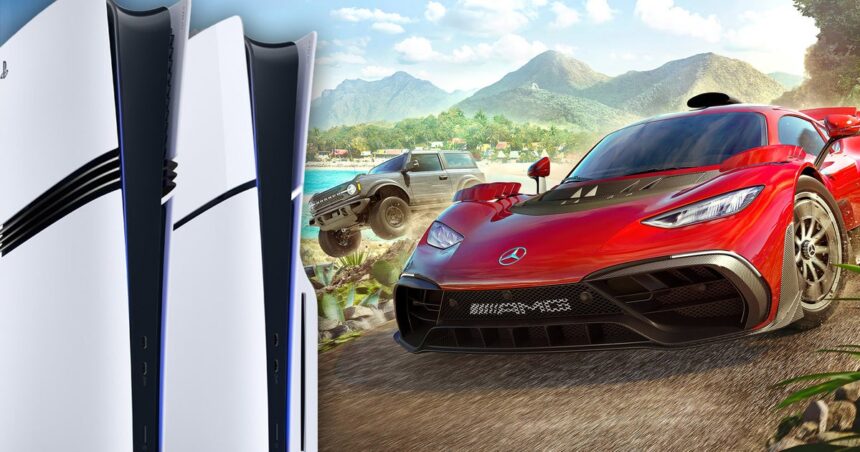Forza Horizon 5 is a truly superb game. This racer packs an enormous amount of content into stunning open-world environments, spanning regions of Mexico and a Hot Wheels paradise in the sky. It’s a top-notch effort from Playground that’s only been available on Xbox and PC, but porting powerhouse Panic Button has just delivered a version of the game for PS5 and PS5 Pro, even sporting RT boosts for Pro users. Is this the definitive Forza Horizon experience on console?
The broad strokes of Forza Horizon 5’s presentation remain unchanged in the move from Series X to PS5, with a 60fps performance mode and a 30fps quality mode. Flipping back and forth between Series X and PS5, there’s virtually no visual distinction, with identical foliage placement, matching terrain and very similar image quality. I’d really struggle to tell the difference between the two platforms in almost any circumstance. That error-free rendition of Forza Horizon 5 is actually a pretty great accomplishment, given that this engine has never run on PlayStation before.
Pixel counts aren’t especially important here, as both consoles typically reach and hold a full 4K. I did notice more evidence of DRS on PS5 in some shots in performance mode, with one example indicating an 1872p internal resolution on PS5 and the full 2160p on Series X, though I don’t expect this difference would be noticeable in actual gameplay. In quality mode, both consoles are locked to a full 4K throughout.
While there are few changes from Series X to PS5, your choice of mode is fairly impactful with more substantial visual differences between quality and performance than we typically see in current-gen releases. The quality mode packs a greater density of assets, stuffing a lot more foliage into every frame. Textures have more layers, and often have high-quality parallax occlusion maps to add additional detail. Pop-in also tends to be much less of a concern, as high-detail versions of the game’s assets stretch far into the distance. Mexico’s sprawling views look quite a bit better in quality mode, especially in the shrubby desert that typifies much of the game’s landmass.
Most console games rely on resolution changes to optimise their performance and quality modes, but Forza depends on visual settings tweaks instead. Image quality across the modes remains similar, though the tradeoff in environment detail is pretty large. It might have been possible to retain the frame-rate of the performance mode with the extended visual quality of the quality mode by using upsampling like FSR 2 instead of the game’s default 4x MSAA, though there are image quality tradeoffs between temporal techniques and MSAA in this game.
In frame-rate terms, both modes are essentially impeccable, offering a consistent 60fps and 30fps update in typical play. That’s not too surprising, considering how well the game operates on the Xbox platforms, but it’s still an impressive feat for how attractive the game is. Pre-rendered movies continue to run at 30fps in both modes, however.
To see this content please enable targeting cookies.
I did notice two small oddities though. The game’s save size – even for a brand new save – is massive, clocking in at over 2GB. There’s only one save per account so this isn’t that big of a deal, but it’s a lot larger than any other save on my PS5 consoles and much bigger than saves from the Series X version of the game. The game’s car physics also seem to differ slightly depending on the mode. If you let the game run out of a cutscene with zero controller input, the car rolls further in quality mode than it does in performance mode, perhaps due to the differing frame-rates. This also appears to be the case on Xbox consoles, so it’s not a new quirk on PS5 machines.
PS5 Pro actually offers some pretty interesting enhancements over the base console, which are most compelling in the game’s performance mode. There’s a huge difference in the game’s foliage. Note the denser and more vibrant greenery in these shots, with bushes and grasses and ferns that just aren’t present on the base machine. Plus, further into the distance, the foliage that is rendered often shows a higher-detail variant relative to the base console, with less visible pop-in. Of course, when you’re barreling through races at speed the advantage on Pro is less palpable. But the difference in density and pop-in is still obvious and highly appreciated.
The Pro performance mode is essentially a match in foliage rendering for the PS5 quality mode in my comparisons, with an equally lavish depiction of flora detail. That’s a great development, given that was the big advantage the quality mode used to have over the performance mode. It’s not exactly the same – the game’s very cool cone step mapping on building exteriors is a quality mode-only feature, for instance. But in typical play, the two modes look quite similar.

Beyond that change, the PS5 and Pro in their respective performance modes appear much the same. Resolution is pretty close as well, though Pro has the advantage here – in the shot where the base machine got pulled to 1872p, the Pro managed to hold a native 2160p. It’s not especially apparent in real-world gameplay in either case, but it does show that Sony’s enhanced machine is pulling this off with frame-time to spare.
The quality mode on Pro is bound to be a little more controversial. In most respects, it’s identical to its base PS5 counterpart, with similar-looking tweakables in my comparison shots. But there is one key point of differentiation – ray-traced vehicle self-reflections during gameplay. Essentially, the player vehicle can now feature reflections of itself, which are layered on top of the game’s real-time cubemap reflections. This is most obvious around mirrors and other protrusions, and cars with chrome or other shiny surfaces. Opposing cars don’t seem to get this treatment, only the player vehicle. The garage and Forzavista feature these reflections on PS5, but they aren’t applied during gameplay. If you go looking for the effect, it is noticeable I would say, even if it isn’t especially visually impactful.
Most of the game’s reflections, though, are still based on other techniques. Their deficits aren’t all that noticeable at the typical pace of play in Forza, so it’s not like you’re losing out on too much in the way of fidelity here. Still, I would have loved a more comprehensive solution for RT reflections – perhaps like the one in Forza Motorsport – though that would probably be outside the scope of a port like this.
Outside of that improvement, the two consoles look essentially identical, matching in every significant respect in my testing. That includes resolution, as both machines seem locked to a full 4K pixel count. Frame-rates on both modes are also just as they were on PS5, which is to say that they reach their respective targets without drops. Expect a locked 30fps in quality mode, with the performance mode holding a steady 60.


There is one curious issue on PS5 Pro though in the current patch. If you turn on the game’s photo mode in quality mode on PS5 Pro during a race event, the game crashes. I was able to replicate this behaviour several times during multiple races, so I suspect this is an issue across the game. The Pro performance mode doesn’t bear this issue, nor does the base machine in either of its modes.
Forza Horizon 5 is an excellent title that is still one of the best-looking racing games ever made. Nothing really comes close to the level of raw environmental fidelity that Forza Horizon 5 so effortlessly accomplishes across its vast open world. Plus, the car models look great, lighting quality is excellent, and performance is typically impeccable across its target platforms. Panic Button’s porting effort certainly does the job too, though the base PS5 essentially comes in exactly as expected. Relative to Series X, it’s a near-perfect match. That’s not a bad thing at all, as the port is consistently high quality and arrives without significant issues.
The Pro is really where the action is at here, specifically in its performance mode. Getting quality mode foliage at performance mode frame-rates is a huge bonus for Pro users, and provides a big visual boost over the base machine. It’s likely the base console could have achieved something similar with a hit to resolution, but this is essentially a compromise-free experience that still typically runs at a full 4K. PS5 Pro’s quality mode is less appealing, just because the added RT makes a minimal difference in most gameplay.
Regardless, Forza Horizon 5 is a great port on Sony’s current-gen consoles. Hopefully we’ll see more from this series soon, but for now this is a great way to enjoy this genre-defining title.





